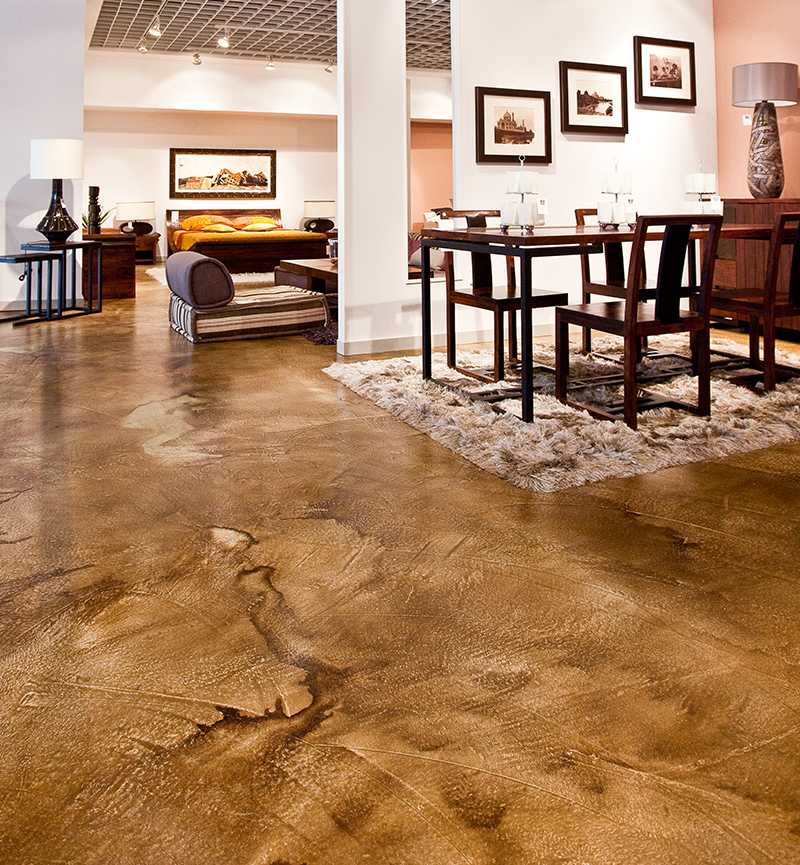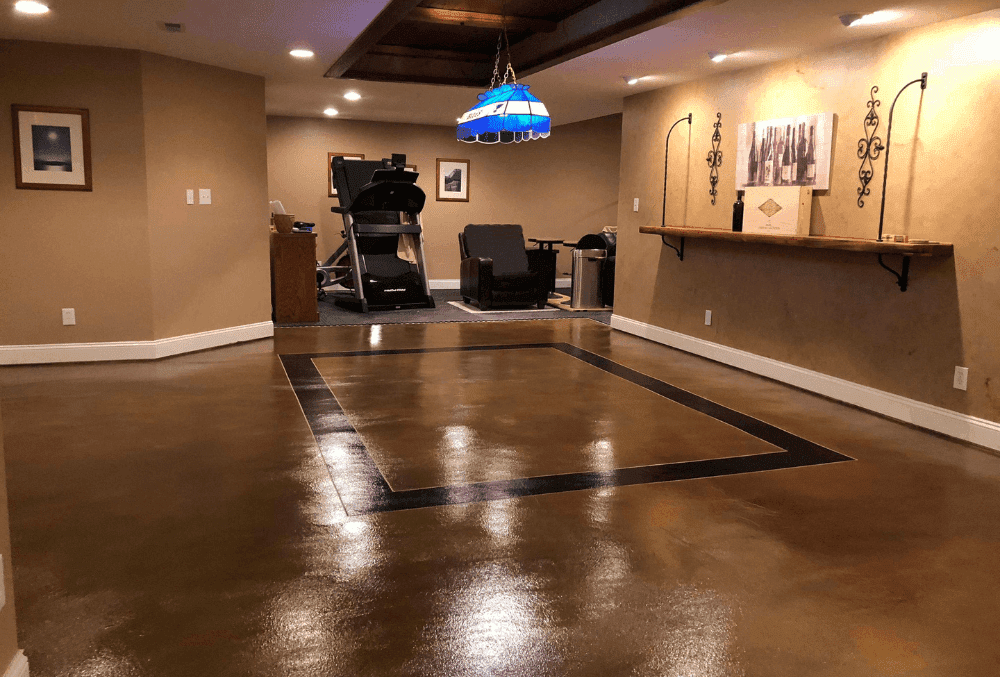Stained concrete austin for kitchens: ideal applications
All Regarding Stained Concrete: A Comprehensive Overview to Its Benefits and Applications
Stained concrete has actually become a popular choice for both residential and industrial rooms. Its capability to incorporate aesthetic allure with practicality makes it an appealing alternative. Various staining techniques use a range of colors and coatings, enabling personalization. The benefits prolong past look. Understanding its applications and maintenance requirements is important for any person considering this versatile product. The subtleties of stained concrete invite better exploration.
What Is Stained Concrete?

Staining can be related to different surface areas, consisting of floors, driveways, and outdoor patios, making it a functional option for both indoor and outdoor areas. The therapy can attain a series of appearances, from earthy tones to bold, modern-day layouts. Unlike paint, stained concrete keeps its look in time, as it ends up being an integral part of the concrete itself. Overall, stained concrete serves as an effective method for transforming common concrete into visually striking surfaces.
Advantages of Stained Concrete
Stained concrete offers significant benefits, particularly in visual allure and toughness - Stained Concrete Floors Austin. Its dynamic shades and one-of-a-kind patterns improve the visual charm of any kind of space, making it a popular choice for both property and industrial applications. Additionally, the longevity of stained concrete warranties that it continues to be a sensible financial investment in time, standing up to damage
Visual Appeal
One of the most engaging benefits of using stained concrete is its exceptional aesthetic appeal. Stained concrete offers an unique and flexible look that can enhance different layout styles, from modern to rustic. The mixture of dynamic shades and elaborate patterns permits homeowners and developers to produce personalized surface areas that can enhance the general setting of an area. Unlike traditional flooring alternatives, stained concrete can imitate the look of all-natural stone or sleek marble, supplying an upscale look without the linked prices. Additionally, the glossy finish choices can mirror light, more lightening up insides. This flexibility makes stained concrete a preferred selection for both domestic and commercial applications, where aesthetic impact is critical.
Resilience and Longevity
The excellent aesthetic top qualities of stained concrete are enhanced by its exceptional toughness and longevity - Austin Stained Concrete Floors. Stained concrete surfaces are resistant to wear and tear, making them suitable for high-traffic locations both indoors and outdoors. Their robust nature means they can hold up against rough weather, consisting of extreme temperatures, rain, and UV exposure, without considerable deterioration. Additionally, stained concrete requires minimal maintenance contrasted to various other floor covering options, as it does not require constant securing or redecorating. This long life not just decreases substitute costs but likewise adds to a sustainable structure approach. On the whole, stained concrete offers an enduring solution that combines aesthetic charm with practical advantages, guaranteeing its worth over time
Various Kinds Of Staining Techniques
Different staining techniques can significantly affect the aesthetic top qualities of concrete surfaces. The three primary techniques include acid staining, which reacts chemically with the concrete, water-based staining, which offers a wider series of colors, and overlay staining alternatives that offer a fresh surface. Each strategy has special qualities and applications that accommodate different style choices and project requirements.
Acid Discoloration Approach
How can home owners transform plain concrete surface areas into visually striking attributes? One effective method is acid discoloration, a popular method that enhances the natural beauty of concrete. This procedure involves using a service of water, hydrochloric acid, and metallic salts to the concrete surface. As the acid reacts with the lime existing in the concrete, it produces rich, variegated shades that appear like marble or rock. Acid staining is recognized for its resilience and resistance to fading, making it a resilient selection for both interior and outside applications. It is vital to keep in mind that the results can vary based on the initial concrete color and appearance. Proper application and securing are important for accomplishing the wanted aesthetic and longevity
Water-Based Discoloration Strategy
A preferred alternative to acid staining, the water-based staining technique provides homeowners a flexible means to improve concrete surface areas. This method utilizes water-soluble dyes and pigments, enabling a vast array of colors and surfaces. Unlike acid discolorations, water-based spots can be related to unsealed concrete and use a much easier clean-up procedure. The results can accomplish an extra consistent appearance and can be layered to develop one-of-a-kind results. In addition, water-based spots are typically much less poisonous and give off fewer volatile organic substances (VOCs), making them a lot more eco-friendly. House owners might value the capability to personalize their concrete surfaces with different tones, enabling imaginative expression while keeping sturdiness and long life in their floor covering selections.
Overlay Staining Options
Various overlay discoloration choices exist for house owners wanting to invigorate their concrete surface areas. One prominent option is acid staining, which responds chemically with the concrete to produce abundant, variegated shades. One more option is water-based discoloration, providing a more comprehensive shade combination and less complicated application. Furthermore, concrete overlays can be incorporated with patterns for elaborate styles, improving aesthetics. For an extra textured surface, property owners may take into consideration using stamped overlays that imitate all-natural products like rock or floor tile. Each strategy gives special advantages, from toughness to customization, permitting for a tailored touch. Ultimately, the choice of overlay discoloration relies on the preferred appearance and the condition of the existing concrete, making sure a freshened and appealing surface.
Applications of Stained Concrete
Stained concrete offers a flexible option for numerous applications, improving both visual appeal and functionality. This material is generally utilized in household, business, and industrial settings, making it a preferred choice amongst engineers and developers. In homes, stained concrete can serve as elegant flooring or outdoor patio areas, giving a sophisticated look while remaining durable.
In commercial areas, such as stores and restaurants, stained concrete adds to a contemporary atmosphere and can withstand heavy foot web traffic. Additionally, stained concrete is progressively used in public spaces like parks and sidewalks, where its capacity to resemble natural stone or various other products includes visual passion.
In addition, stained concrete is ideal for pool decks and driveways, providing a slip-resistant surface that is easy to keep. Generally, the adaptability of stained concrete makes it ideal for numerous environments, satisfying varied preferences and demands.
Upkeep and Care for Stained Concrete
Appropriate upkeep guarantees the long life and charm of stained concrete surface areas. Normal cleansing is essential; making use of a light detergent and water with a soft-bristle brush assists remove dust and crud without harming the surface. It is recommended to stay clear of harsh chemicals that can remove away the tarnish or sealant.
Securing stained concrete is important for defense versus moisture, discolorations, and wear. A premium sealant ought to be reapplied each to three years, relying on the web traffic and exposure the surface withstands. Additionally, dealing with spills promptly will avoid staining and discoloration.

Price Factors To Consider for Stained Concrete Projects
When planning a discolored concrete job, budget plan considerations play a vital duty in identifying the overall price. The costs related to stained concrete can differ substantially based upon a number of aspects. First, the dimension of the location to be stained straight influences material and labor prices. Larger areas will normally require even more sources. Second, the sort of discolor selected-- acid-based or water-based-- can affect prices, with acid discolorations typically being more pricey. In addition, the complexity of the design, consisting of patterns or numerous shades, can enhance labor prices. Preparation job, such as cleaning and grinding the concrete surface, includes in the initial costs as well. Ultimately, the choice between do it yourself installment and working with a specialist specialist will certainly better impact the budget plan. Recognizing these factors enables home owners to make educated economic choices concerning their stained concrete jobs, ensuring they accomplish the preferred aesthetic within their monetary methods.
Tips for Choosing the Right Stained Concrete for Your Area
Selecting the best stained concrete for a certain area includes cautious contemplation of numerous variables beyond just spending plan. One ought to assess the desired usage of the location. High-traffic zones may call for more long lasting coatings, while decorative applications can focus on aesthetic appeals.
The color combination is an additional essential element; the chosen colors should balance with existing design and illumination. It's additionally essential to take right into account the surface area appearance, as smooth finishes can enhance class, while distinctive options might guarantee safety and security in wet areas.
Local climate and ecological problems play a considerable function in the long life and maintenance of stained concrete, influencing the choice of sealants and surfaces.
Finally, talking to professionals can give beneficial insights customized to certain needs, assuring the choice of the ideal stained concrete that straightens with both functionality and design.

Frequently Asked Concerns
Can Stained Concrete Be Applied Over Existing Flooring?
Stained concrete can without a doubt be used over existing flooring, supplied more info the surface area is stable and effectively prepared. This technique permits for an aesthetic upgrade without the need for full removal of the original flooring materials.
The Length Of Time Does Stained Concrete Last?
Stained concrete can last for decades when properly kept. Variables such as website traffic, ecological conditions, and application techniques greatly affect its durability, with several setups remaining vibrant and undamaged for 10 to thirty years.
Is Stained Concrete Slippery When Wet?
Stained concrete can be slippery when wet, as the finish might create a smooth surface. However, using non-slip additives or textured finishes can reduce this problem, boosting safety and security without compromising the aesthetic appeal of the concrete.
Can I Discolor Concrete Myself, or Should I Hire an Expert?
The decision to stain concrete personally or work with an expert rest on ability degree and project complexity. While DIY discoloration can save money, experts ensure perfect outcomes, specifically for complex layouts or huge surfaces.
What Colors Are Readily Available for Stained Concrete?
The range of colors offered for stained concrete includes earthy tones like browns and tans, lively tones such as reds and blues, and softer tones like pastels. This combination enables imaginative, personalized layout choices.